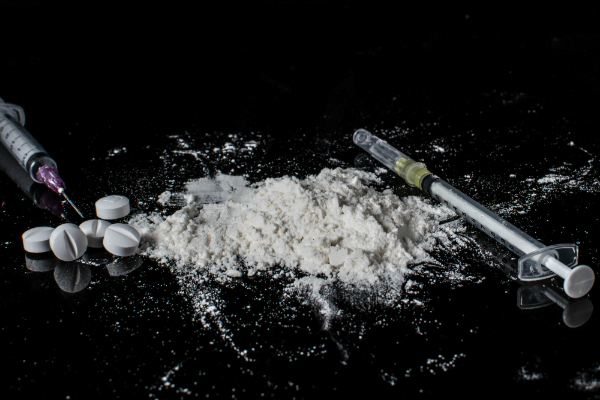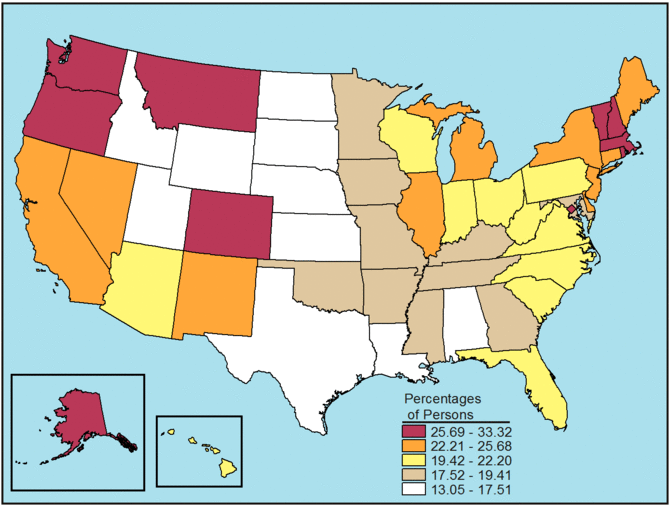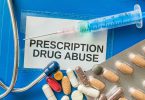In 2012, about one-fifth of the 35.6 million college-aged individuals in America has used an illicit drug within the 30 days before participating in the survey.
Emergency rooms are seeing increases in visits from those in this age group due to drug-related illnesses and overdoses. Young people between the ages of 18 and 25 use illicit drugs in every state; with some states having higher rates of these occurrences than others.
Each state is color-coded to represent a percentage category. These categories reflect the percentage of those between the ages of 18-25 who had reported illicit substance use within the previous month. Information collected from the National Surveys of Drug Use and Health of 2011 and 2012 were averaged for the purpose of this illustration.
The states with the highest percentage are colored red. The states are: Alaska, Colorado, District of Columbia, Massachusetts, Montana, New Hampshire, Oregon, Rhode Island, Vermont, and Washington. Each of these states reported 25.69 to 33.32 percent of college-aged individuals with recent illicit drug use.
The states that reported 22.21 to 25.68 percent are orange and include California, Connecticut, Delaware, Illinois, Maine, Michigan, Nevada, New Jersey, New Mexico, and New York.
The yellow states—Arizona, Florida, Hawaii, Indiana, North Carolina, Ohio, Pennsylvania, South Carolina, Virginia, West Virginia, and Wisconsin—indicate that 19.42 to 22.20 percent of their young people admitted to using illicit substances recently.
Arkansas, Georgia, Iowa, Kentucky, Maryland, Minnesota, Mississippi, Missouri Oklahoma, and Tennessee are tan and report 17.52 percent to 19.41 percent.
Alabama, Idaho, Kansas, Louisiana, Nebraska, North Dakota, South Dakota, Texas, Utah, and Wyoming which represent the lowest percentage category: 13.05 to 17.51 percent and are colored white. These are the states with the fewest college-aged individuals using illicit substances within the previous month.
States with Highest Opioid Use by People Ages 18 to 25
Julie Bosman of the New York Times said, “The opioid epidemic killed more than 33,000 people in 2015” and that “Opioid addiction is America’s 50-state epidemic.”
Experts estimate that prescriptions for opiates were written 210 million times in 2010. Long-term use greatly increases the likelihood of physical and psychological dependency; many patients develop a heroin addiction over the course of an opioid dependency.
Every state across the country struggles with the Opioid epidemic. These 10 states have the highest use among young people:
- Ohio
- New York
- Florida
- Pennsylvania
- California
- Texas
- Illinois
- Massachusetts
- New Jersey
- Michigan
Stimulant Use in States by College-Aged Individuals
Ritalin and Adderall are two of the most common medications misused in the stimulants category. Doctors commonly prescribe them to treat ADHD, narcolepsy, and depression while young people use them recreationally for their temporary euphoric sensation and increase in concentration and alertness.
Stimulants, including methamphetamine, are the most common reason for treatment facility admissions in the states of Nebraska, Utah, and Nevada, with Arkansas, Hawaii, Iowa, Kansas, Missouri, Oklahoma, South Dakota and Washington following closely behind.
In California, 36 percent of admitted stimulant users sought the help of treatment facilities to overcome their addiction.
States in which Young People Use Marijuana Most Often
Marijuana has been the topic of a long-term debate on its dangers as a gateway drug and its place in the medical industry as a successful treatment for a variety of conditions.
Marijuana is the most used substance in over half the states in the country:
- Alabama
- Alaska
- Arkansas
- Colorado
- Florida
- Hawaii
- Idaho
- Indiana
- Iowa
- Kansas
- Louisiana
- Michigan
- Minnesota
- Mississippi
- Missouri
- Montana
- North Carolina
- North Dakota
- Ohio
- Oklahoma
- Oregon
- South Carolina
- South Dakota
- Texas
- Virginia
- Washington
- Wisconsin
- Wyoming
As many states have passed laws that allow Marijuana use both medically and recreationally, many people, between the ages of 18 and 25, in every state, use the drug without consideration for the dangers it enhances in risky behaviors, such as driving while under the influence.
States with Overdose Support for Young Adults Who Use Substances
The Huffington Post remarked on a map that illustrated where invaluable life-saving laws have been successful and where attention is needed.
Over the course of 11 years, Maryland had lowered their overdose rates to virtually none while California, Nevada, Arizona, New Mexico, Illinois, Washington and several states in New England follow close behind.
Many of these states implemented “Good Samaritan” laws, which protect those who need medical assistance during an overdose. This has encouraged those in need of help to feel safe from legal repercussions to ask for it.
Rates in which overdose deaths continue to rise are expectedly in states that don’t have “Good Samaritan” laws in place, such as Missouri, Indiana, Ohio and West Virginia, a state of specific concern.
Every State Has Young Adult Residents Who Use Illicit Drugs
No state is immune to the phenomenon of illicit drug use by young adults. These substances are easy to obtain and many people in this age group develop a curiosity in what others use as a crutch to get through the hardships that come with becoming a responsible adult.
Young people in these states who are using illicit drugs often tend to become addicted without realizing it.
Parties, concerts, finals, and cram sessions are all distractions that make it easy for the user to feel that they have their usage under control.
Many times, substance use helps individuals to self-medicate co-occurring conditions they may not be aware of, contributing to addiction. For example, many young people use drugs that could help someone with depression feel more social.
Substance abuse treatment facilities work with individuals to uncover these conditions. Properly treating them with appropriate medications and other methods—such as therapy—will loosen the grip the substance could have on one’s life.
If you are concerned about your substance abuse or the substance use of someone you care about, contact us today. We can help you take your first step in the right direction.
Many treatment program graduates have found that they are able to live a happy, healthy life and be successful without the use of substances. Call us today.
















